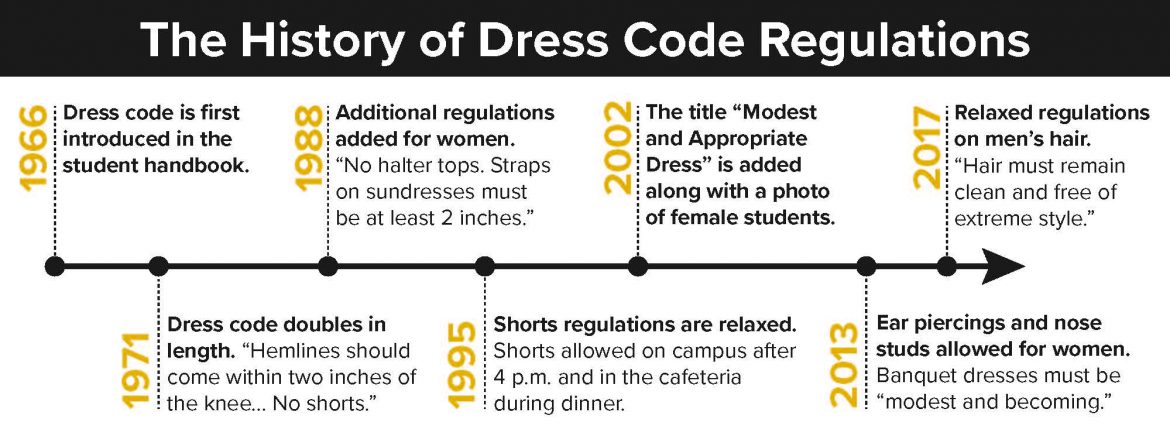At Harding, the virtue of modest and appropriate dress is enforced with the student handbook. However, it hasn’t always been this way.
Although Harding College was founded in 1924, student dress was not mentioned in the handbook until 1966. Since then, the student dress code has only expanded with the trends of the decades.
Former professor Dr. Beth Wilson, who first came to Harding to teach in the early 70s, spoke about the university’s strict dress code that was in place when she began teaching.
According to Wilson, there were some faculty members who would measure the length of female students’ skirts to promote modesty.
In the late 90s, Harding incorporated a section of the student handbook titled “Modest and Appropriate Dress.” This section included dress codes for both men and women, but for nearly a decade, the section’s accompanying picture was one of only female students.
The 2017-2018 Student Handbook’s chapter, “Modest and Appropriate Dress” features the Bible verses 1 Peter 3:3-4, a passage written to female Christian exiles, specifically married women.
According to page 20 of the handbook, “All members of the Harding community are expected to maintain standards of modesty and decency in dress appropriate to the Christian lifestyle and consistent with professional employment expectations.”
Dean of Students Zach Neal said the dress code is applicable for all students to maintain the character of Harding.
“A potential misunderstanding is that the university is attempting to define modesty itself when we are simply providing a consistent, clear standard of what is expected for our campus,” Neal said. “We evaluate the handbook, including dress code, every year and listen to all feedback throughout the year. We realize that our students come from many different backgrounds.”
According to alumna Madeline Jones, who graduated in May, modesty in Christian circles and at Harding tend to focus heavily on outward appearance rather than inner traits. She said that modesty, though it is supposed to prevent the objectification of women, ironically leads to just that, but within the church.
Jones, who did not grow up in a religious household, said arriving at a university with a strict dress code was shocking.
As a freshman, Jones said she was the “perfect Harding student,” too afraid to challenge the pervasive view of modesty. She said modest clothing can have a reputation of being “frumpy, white-washed and not defining.” Her style and her sense of modesty now is less about how much skin she is showing and more about her own self-worth, confidence and discretion.
“I think modesty is so cultural, and I think it is situational,” Jones said. “I was taught modesty to think outside of myself and to never offend who you’re going to be with. Modesty for me is respect for myself and for other people, and I think that’s a line that gets crossed a lot.”
Jones said she believed it was common for faculty and staff to ask female students to change clothes if they were seen violating dress code. She found it frustrating to be asked to change out of clothes that her parents would not see as promiscuous.
“I feel like all we do is shame when it comes to modesty instead of cultivating uniqueness and personalized ways to view modesty,” Jones said. “It’s just like putting me in a box. That seems very counterproductive because we all deal with shame — especially women.”
Director of Academic Resources Stephanie O’Brian discussed one memory from her time as a Harding student in which her professor halted the lecture and publicly asked her to leave class and change clothes. O’Brian said she was wearing capri-length pants that were a few inches below the knee but the professor referred to them as “shorts,” which are by dress code standards not allowed in class at all.
O’Brian described feeling embarrassed and ashamed leaving mid-class to change her clothes.
According to Neal, the goal of the dress code in the Student Handbook is to make sure the expectations are clear for both men and women.
“It is never our intent to embarrass or call attention to someone in violation of the dress code so we always attempt to find the best approach to the conversation whether that be from faculty, staff or a Student Life dean in a classroom, residence hall or office,” Neal said. “Ideally, adherence to the expectations comes through personal awareness and commitment to honor the stated guidelines.”
According to Jones, however, this conversation is not always an easy one.
“When modesty is done the wrong way,” Jones said, “it just cultivates shame.”
This is the second installment of “The M-Word” series. The final installment will appear in the next edition of The Bison, on stands Dec. 8.
